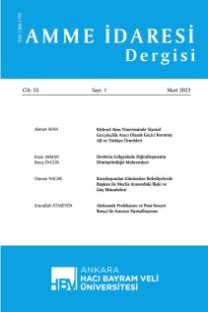Akademisyenlerin Mesleki Yardımlaşması: Erciyes Üniversitesi Örneği
Professional Solidarity Among the Academicians
___
- Austin, Ann E. ve Baldwin, Roger G. (1992),"Faculty Collaboration: Enhancing teh Quality of Scholarship and Teaching", ERIC Clearinghouse on Higher Education, Washington DC/BBB27915, George Washington University, Washington DC.
- Bayer, A. E. ve Smart, J. C. (1998), "Author Collaborative Styles in Academic Scholarship", Paper presented at an annual meeting of the American Educational Research Association, April, New Orleans, Louisiana.
- Burnett, R. ve Ewald, H.R. (1994), "Rabbit trails, ephemera, and other stories: Feminist methodology and collaborative research", Journal of Advanced Composition, 14 (l):9-2l.
- Castle, J.B. ve Giblin, A. (1992), Reflection-for- action: "A collaborative venture in pre-service education", Teaching Education, 4 (2), 21-34.
- Chubin, D.,-Porter, A.- ve Rossini, F. (eds.), (1985) Interdisiplinarity: Theory ve Practice of problem focused research and development, Mt. Airy, MD.: London Publishing. Cornesky," R. ve McCool, S. (1992), Total Quality Improvement Guide for Institutes of Higher Education, WI: Magna Publications, Inc.
- Çakın, İ. (1998), "Üniversitelerimizin Bilgiye Erişim Ortamları", Hacettepe Üniversitesi Edebiyat Fakültesi Dergisi, Cumhuriyetimizin 75. Yılı Özel Sayısı, 37-67.
- Hafernik, J.J, ve Vandrick, S. (1997), "Collaborative research: Why and how?", Educational Researcher, 26 (9), 31-35.
- Kaptan, S. (1995), Bilimsel Araştırma ve İstatistik Teknikleri, Ankara: Gazi Eğitim Fak.
- Karasar, N. (1994), Bilimsel Araştırma Yöntemi: Kavramlar, İlkeler, Teknikler, Ankara: 3A Araştırma Eğitim Danışmanlık.
- Knowles, M.S. (1990), The Adult Learner, Houston: Gulf Publishing Company.
- Kochan, PC.F. ve Mullen, C.A. (2001), "Issues of collaborative authorship in higher education", The Educational Forum, Vol. 65, Winter, 129-135.
- Krovetz, M. ve Cohick, D. (1993), "Professional collegiality can lead to school change ", Phi Delta Kappan, 75, 331-335.
- Marlow, M. P. (2000), "Collegiality, collabortaion, and Kuleana: Three crucial components for sustaining effective school", Education, Vol. 121, Issue 1, 188-196.
- Miller, S. M.,-Nelson, W.- ve Moore, T.M. (1998), "Caught in the paradigm gap: Qualitative researchers' lived experience and the politics of epistemology", American Educational Research Journal, 35 (3):377-416.
- Moore, D. R. (1999), "Collaborative Leadership: Working together to understand, differences", International Journal of Scholarly Academic Intellectual Diversity (IJSAID), Vol. 3, Number 1, 1-4. http://www.nationalforum.com/moore.htm (11.12.2001).
- Massey,W.F.-Wilger, A.K.-Colbeck, C. (1994), "Overcoming 'hallowed' collegiality", Change, 26, 11-20.
- Mullen, C.A. ve Kochan, F.K. (2000), "Creating a collaborative leadership network:An organic view of change", International Jounral of Leadership in Education: Theory . & Practice3 (1):81-2QQ.
- Rider, J. ve Broughton, E. (1994), "Moving out, moving up: Beyond the basement and ivory tower", Journal of Advanced Composition, 14 (l):239-255.
- Ruddick, J. (1992), Universities in partnership whith schools and school systems: Les liaisons dangereuses? In M. Fuallan ve A. Hargreaves (Eds.),Teacher development and educational change (pp. 194-212), Washinghton, DC: Palmer Press.
- Scott, J. A. ve Bereman, N. A. (1992), "Competation vs. collegiality: Academe's dilemma for the 90's" Journal of Higher Education, 63, 684-700.
- Üniversitelerarası Kurul'un ve Kurul'a Bağlı Komisyonların Çalışma Esasları Yönetmeliği, http//www.yok.gov.tr/uak/menu/docent-duy-kll.html(16.11.2001)
- Zoglio, S. (1999), "Ekipler İş Başında", Exectutive Excellence, Ocak, 22.
- ISSN: 1300-1795
- Yayın Aralığı: 4
- Başlangıç: 1968
- Yayıncı: -
Baskı Grupları ve Karar Alma Mekanizmasına Etkileri
Turkut GÖKSU, Veysel K. BİLGİÇ
Neo-Liberal Politikalar ve Yönetişim Modeli
Kamu Çalışanlarının Kalite Yönetimi Yaklaşımı
Eğitim Birliği Yasası Açısından Liselerdeki Eğitimin Durumu
Duyun-ı Umumiye İdaresine Memur Olmak
Yozlaşma ve Türk Siyasal Yaşamın Yeniden Yapılanması: Bir Model Önerisi
Akademisyenlerin Mesleki Yardımlaşması: Erciyes Üniversitesi Örneği
